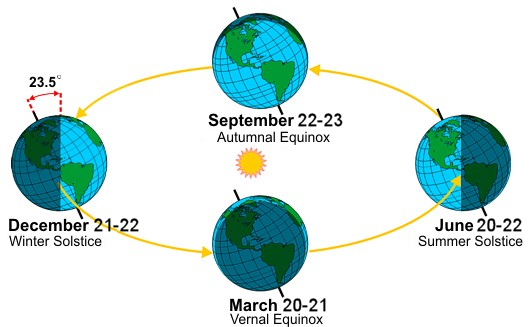Summer Solstice: 21st June | 21 Jun 2022
For Prelims: Summer Solstice, Winter Solstice, Equinox
For Mains: Summer Solstice, Geography behind Solstice, Physical Geography, Important Geophysical Phenomena
Why in News?
21st June is the day of the Summer Solstice in the northern hemisphere.
- The day is observed as the International Day of Yoga.
What is the Summer Solstice?
- About:
- Solstice is a Latin word that means ‘stalled sun’. It is a natural phenomenon that occurs twice every year, once in the summer and again during winter, in each hemisphere of the earth - Summer and Winter Solstice.
- It is the longest day and shortest night of the year in the Northern Hemisphere.
- During this, countries in the Northern Hemisphere are nearest to the Sun and the Sun shines overhead on the Tropic of Cancer (23.5° North).
- At latitudes of 23.5° are the Tropics of Cancer and Capricorn, north and south of the Equator.
- At 66.5° are the Arctic and Antarctic Circles, to the north and south.
- Latitudes are a measure of a location’s distance from the Equator.
- During the solstice, the Earth’s axis — around which the planet spins, completing one turn each day — is tilted in a way that the North Pole is tipped towards the sun and the South Pole is away from it.
- Typically, this imaginary axis passes right through the middle of the Earth from top to bottom and is always tilted at 23.5 degrees with respect to the sun.
- Greater Amount of Energy:
- This day is characterised by a greater amount of energy received from the sun. According to NASA (National Aeronautics and Space Administration), the amount of incoming energy the Earth received from the sun on this day is 30% higher at the North Pole than at the Equator.
- The maximum amount of sunlight received by the Northern Hemisphere during this time is usually on June 20, 21 or 22. In contrast, the Southern Hemisphere receives most sunlight on December 21, 22 or 23 when the northern hemisphere has its longest nights– or the winter solstice.
What is the Geography Behind the Solstice?
- The reason behind it is the changing lengths of the days is the Earth’s tilt.
- The Earth’s axis of rotation is tilted at an angle of 23.5° to its orbital plane. This tilt, combined with factors such as Earth’s spin and orbit, leads to variations in the duration of sunlight, due to which any location on the planet receives different lengths of days.
- The Northern Hemisphere spends half the year tilted in the direction of the Sun, getting direct sunlight during long summer days. During the other half of the year, it tilts away from the Sun, and the days are shorter.
- The tilt is also responsible for the different seasons on Earth. This phenomenon causes the movement of the Sun from the northern to the southern hemisphere and vice versa bringing in seasonal changes in the year.
What is the Equinox?
- Twice each year, during the equinoxes (“equal nights”), Earth's axis is not pointed toward our Sun, but is perpendicular to the incoming rays.
- It results in a "nearly" equal amount of daylight and darkness at all latitudes.
- The vernal or spring equinox occurs in the northern hemisphere on March 20 or 21. September 22 or 23 marks the northern hemisphere autumnal or fall equinox.
UPSC Civil Services, Previous Years Questions (PYQ)
Q. On 21st June, the Sun (2019)
(a) does not set below the horizon at the Arctic Circle
(b) does not set below the horizon at Antarctic Circle
(c) shines vertically overhead at noon on the Equator
(d) shines vertically overhead at the Tropic of Capricorn
Ans: (a)
Exp:
- During ‘Summer Solstice’, on 21st June, the Northern Hemisphere witnesses its longest day of the year, while the Southern Hemisphere sees its shortest day. During this time, the Earth’s North Pole is at its maximum tilt towards the Sun and the Sun appears directly overhead at 23.5º north latitude, i.e. along the Tropic of Cancer.
- As the Arctic Circle falls in the Northern Hemisphere, the Sun does not set below the horizon during Summer Solstice, because here the sunrise and sunset start to converge in the northern sky. In contrast, the same event happens in the Antarctic Circle during Winter Solstice, 22nd December. Therefore, option (a) is the correct answer.

